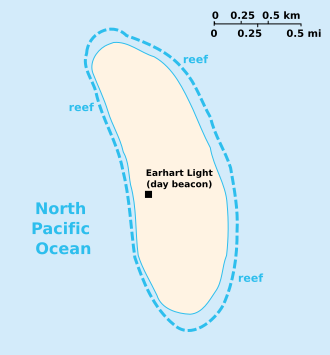Howland Island





Howland Island is an uninhabited coral island located in the central Pacific Ocean, about 1,700 nautical miles (3,100 km) southwest of Honolulu. Politically, it is an unincorporated, unorganized territory of the United States, managed by the U.S. Fish and Wildlife Service as part of the Pacific Remote Islands Marine National Monument. Howland Island is perhaps best known for its role in the disappearance of Amelia Earhart, who vanished in 1937 while attempting to make a circumnavigational flight of the globe in her Lockheed Model 10-E Electra, with Howland Island intended as a refueling stop.
History[edit]
The island was sighted in 1842 by the American whaling ship Oeno and was named after a lookout who first spotted it. Initially, it was annexed by the United States in 1857 under the Guano Islands Act for its guano deposits, though these were never exploited. In the late 1930s, Howland Island gained international attention as a planned refueling stop for Amelia Earhart's ill-fated around-the-world flight. Despite extensive search efforts, neither Earhart nor her navigator, Fred Noonan, were ever found, and the mystery of their disappearance remains one of the 20th century's most enduring.
During World War II, the United States attempted to establish a presence on Howland Island, constructing an airstrip and other facilities. However, the island was attacked by Japanese forces, leading to its abandonment. Post-war, the island was occasionally visited for scientific and environmental monitoring but has remained uninhabited.
Geography[edit]
Howland Island is a flat, sandy island surrounded by a narrow fringing reef. It is about 1.8 square kilometers in area, with its highest point being only about 6 meters above sea level. The island's geography makes it susceptible to the effects of climate change, including sea-level rise and increased storm intensity. The island supports a variety of wildlife, including seabirds, marine turtles, and the endemic Howland Island rail, which was last seen in the 1940s and is presumed extinct.
Ecology[edit]
As part of the Pacific Remote Islands Marine National Monument, Howland Island is protected under U.S. law. The island and its surrounding waters are home to a diverse range of species, many of which are protected or endangered. Efforts to remove invasive species and protect the island's native flora and fauna have been ongoing. The island's isolation and lack of human presence have made it an important site for studying Pacific island ecosystems and the impacts of climate change.
Legacy[edit]
Howland Island's most enduring legacy is its connection to Amelia Earhart and the mystery surrounding her disappearance. The island is a symbol of early aviation history and the challenges faced by pioneers like Earhart. It also serves as a reminder of the importance of preserving remote, uninhabited islands for their ecological, historical, and scientific value.
Ad. Transform your life with W8MD's Budget GLP-1 injections from $75


W8MD offers a medical weight loss program to lose weight in Philadelphia. Our physician-supervised medical weight loss provides:
- Weight loss injections in NYC (generic and brand names):
- Zepbound / Mounjaro, Wegovy / Ozempic, Saxenda
- Most insurances accepted or discounted self-pay rates. We will obtain insurance prior authorizations if needed.
- Generic GLP1 weight loss injections from $75 for the starting dose.
- Also offer prescription weight loss medications including Phentermine, Qsymia, Diethylpropion, Contrave etc.
NYC weight loss doctor appointmentsNYC weight loss doctor appointments
Start your NYC weight loss journey today at our NYC medical weight loss and Philadelphia medical weight loss clinics.
- Call 718-946-5500 to lose weight in NYC or for medical weight loss in Philadelphia 215-676-2334.
- Tags:NYC medical weight loss, Philadelphia lose weight Zepbound NYC, Budget GLP1 weight loss injections, Wegovy Philadelphia, Wegovy NYC, Philadelphia medical weight loss, Brookly weight loss and Wegovy NYC
|
WikiMD's Wellness Encyclopedia |
| Let Food Be Thy Medicine Medicine Thy Food - Hippocrates |
Medical Disclaimer: WikiMD is not a substitute for professional medical advice. The information on WikiMD is provided as an information resource only, may be incorrect, outdated or misleading, and is not to be used or relied on for any diagnostic or treatment purposes. Please consult your health care provider before making any healthcare decisions or for guidance about a specific medical condition. WikiMD expressly disclaims responsibility, and shall have no liability, for any damages, loss, injury, or liability whatsoever suffered as a result of your reliance on the information contained in this site. By visiting this site you agree to the foregoing terms and conditions, which may from time to time be changed or supplemented by WikiMD. If you do not agree to the foregoing terms and conditions, you should not enter or use this site. See full disclaimer.
Credits:Most images are courtesy of Wikimedia commons, and templates, categories Wikipedia, licensed under CC BY SA or similar.
Translate this page: - East Asian
中文,
日本,
한국어,
South Asian
हिन्दी,
தமிழ்,
తెలుగు,
Urdu,
ಕನ್ನಡ,
Southeast Asian
Indonesian,
Vietnamese,
Thai,
မြန်မာဘာသာ,
বাংলা
European
español,
Deutsch,
français,
Greek,
português do Brasil,
polski,
română,
русский,
Nederlands,
norsk,
svenska,
suomi,
Italian
Middle Eastern & African
عربى,
Turkish,
Persian,
Hebrew,
Afrikaans,
isiZulu,
Kiswahili,
Other
Bulgarian,
Hungarian,
Czech,
Swedish,
മലയാളം,
मराठी,
ਪੰਜਾਬੀ,
ગુજરાતી,
Portuguese,
Ukrainian
